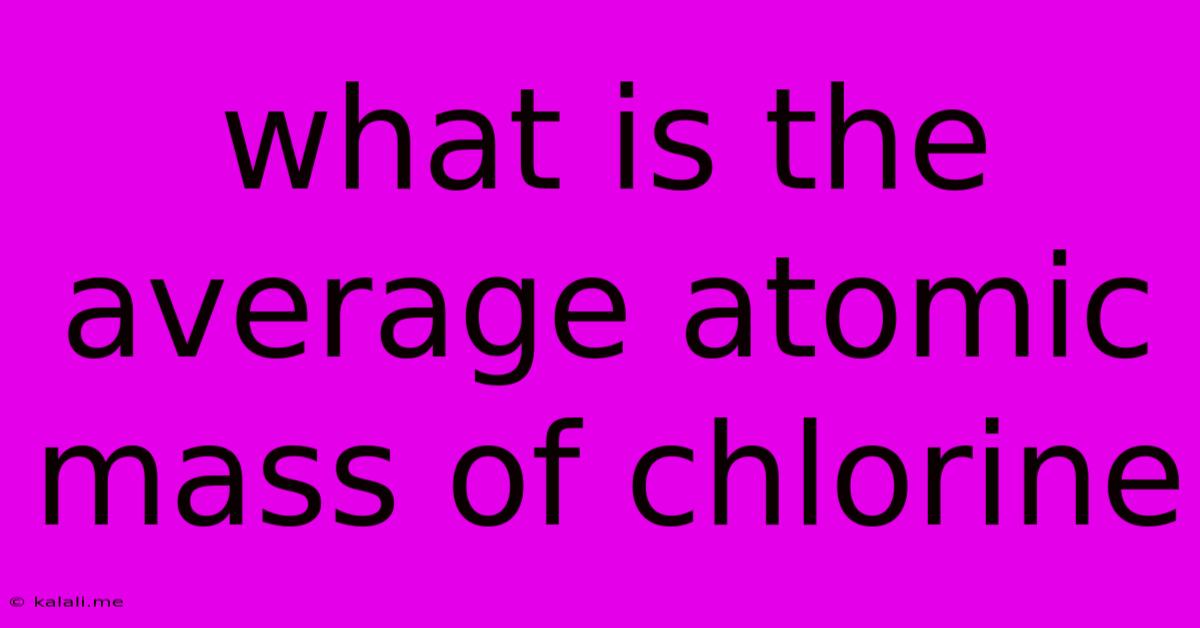What Is The Average Atomic Mass Of Chlorine
Kalali
Jun 16, 2025 · 2 min read

Table of Contents
What is the Average Atomic Mass of Chlorine? Understanding Isotopes and Weighted Averages
Chlorine, a crucial element in everyday life, isn't as simple as its position on the periodic table suggests. Understanding its average atomic mass requires delving into the world of isotopes and weighted averages. This article will explain what the average atomic mass of chlorine is and how it's calculated.
What is Atomic Mass?
Atomic mass, also known as atomic weight, represents the total mass of protons and neutrons in a single atom of an element. It's expressed in atomic mass units (amu), where one amu is approximately equal to the mass of a single proton or neutron. However, things get a bit more complicated when we consider isotopes.
Isotopes: The Chlorine Twist
Isotopes are atoms of the same element with the same number of protons but a different number of neutrons. This means they have the same atomic number but different mass numbers (protons + neutrons). Chlorine has two naturally occurring isotopes:
- Chlorine-35 (³⁵Cl): This isotope accounts for approximately 75.77% of naturally occurring chlorine. It has 17 protons and 18 neutrons.
- Chlorine-37 (³⁷Cl): This isotope makes up about 24.23% of naturally occurring chlorine. It has 17 protons and 20 neutrons.
Because chlorine exists as a mixture of these two isotopes, its atomic mass isn't simply the mass of one isotope. Instead, we need to calculate a weighted average.
Calculating the Average Atomic Mass of Chlorine
To determine the average atomic mass, we consider the mass of each isotope and its relative abundance. The calculation is a weighted average:
(Abundance of ³⁵Cl × Mass of ³⁵Cl) + (Abundance of ³⁷Cl × Mass of ³⁷Cl) = Average Atomic Mass of Chlorine
Let's plug in the numbers:
- Abundance of ³⁵Cl: 0.7577
- Mass of ³⁵Cl (approximately): 34.96885 amu
- Abundance of ³⁷Cl: 0.2423
- Mass of ³⁷Cl (approximately): 36.96590 amu
(0.7577 × 34.96885 amu) + (0.2423 × 36.96590 amu) ≈ 35.45 amu
Therefore, the average atomic mass of chlorine is approximately 35.45 amu. This value is what you'll find on the periodic table. Remember that this is a weighted average reflecting the natural abundance of chlorine's isotopes.
Significance of Average Atomic Mass
The average atomic mass is crucial in various chemical calculations, including:
- Stoichiometry: Determining the amounts of reactants and products in chemical reactions.
- Molar mass calculations: Finding the mass of one mole of a substance.
- Understanding chemical properties: While isotopes have similar chemical properties, their slight mass differences can influence reaction rates and other properties in certain contexts.
Understanding the concept of isotopes and their contribution to the average atomic mass of elements like chlorine is fundamental to grasping key concepts in chemistry and related fields. This weighted average provides a representative value for the mass of chlorine atoms as they exist in nature.
Latest Posts
Latest Posts
-
How To Create Clickable Image In Html
Jun 16, 2025
-
What Are The Factors Of 121
Jun 16, 2025
-
What Is A Theme Of The Passage
Jun 16, 2025
-
A Company That Provides Access To The Internet
Jun 16, 2025
-
Which Word Is Closest In Meaning To The Underlined Word
Jun 16, 2025
Related Post
Thank you for visiting our website which covers about What Is The Average Atomic Mass Of Chlorine . We hope the information provided has been useful to you. Feel free to contact us if you have any questions or need further assistance. See you next time and don't miss to bookmark.